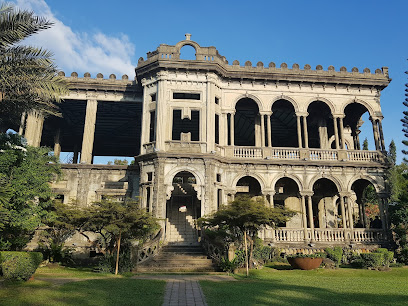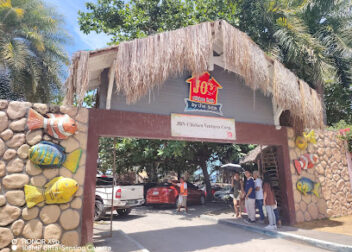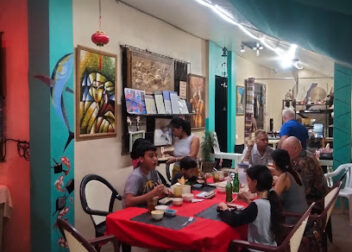What are the historical sites in Negros Oriental?
If you’re a history buff or just someone who loves discovering the stories behind places, you’re in for a treat with Negros Oriental. Nestled in the heart of the Visayas region, this province is brimming with historical treasures that tell the tale of its vibrant past. From centuries-old churches to colonial-era mansions, each site offers a unique glimpse into the rich cultural heritage that shapes the identity of its people today. In this blog post, we’ll take you on a journey through some of the most significant historical sites in Negros Oriental, sharing insights and experiences that will not only enrich your visit but also deepen your appreciation for this captivating region. So, let’s dive in and uncover the stories waiting to be told!
Historical Significance of Negros Oriental
Negros Oriental is not just a picturesque province in the Philippines; it carries a rich tapestry of history that has shaped its cultural landscape. From its role during the Spanish colonial period to the American occupation, the province has a unique story that resonates with its people today. Let’s dive into the significant historical milestones that have influenced the identity of Negros Oriental.
Spanish Colonial Period: The Foundation of Identity
Early Colonization
When the Spanish arrived in the Philippines in the 16th century, they quickly recognized the fertile lands of Negros Island. The province was officially established in 1583 and became a crucial agricultural hub. The introduction of sugarcane farming transformed the economy, leading to the emergence of haciendas (large estates) owned primarily by Spanish and mestizo elites.
- Hacienda Luisita: One of the most notable haciendas during this period, it set the stage for socio-economic dynamics that would shape the province for generations.
Cultural Influences
The Spanish brought with them various cultural influences, including religion, architecture, and education. The introduction of Catholicism has left an indelible mark, with numerous churches constructed in the Baroque style, such as the San Isidro Labrador Church in Amlan. Festivals like the Sinulog Festival showcase this blend of indigenous and Spanish traditions, celebrating the province’s patron saint with vibrant parades and dances.
American Occupation: A New Era
Transition of Power
Following the Spanish-American War in 1898, the Philippines came under American control. This period marked significant changes in governance, education, and infrastructure. The Americans implemented public education and introduced a democratic form of government, which allowed for more local participation in governance.
- Negros Oriental High School: Established during this time, it became a symbol of the American educational system’s influence on the province.
Economic Developments
Under American rule, the economy of Negros Oriental diversified. While sugar continued to be a dominant crop, other industries began to flourish, including coconut and tobacco farming. The establishment of modern transportation, such as roads and ports, facilitated trade and commerce.
Post-War Development: Modernization and Growth
Towards Progress
After World War II, Negros Oriental experienced a period of reconstruction and growth. The provincial government focused on rebuilding infrastructure and improving public services, which paved the way for economic development.
- Dumaguete City: Often referred to as the “City of Gentle People,” it became a center for education and culture, home to institutions like Silliman University, the first American university in the Philippines, established in 1901.
Key Industries
Today, Negros Oriental is known for several key industries that reflect its historical roots:
- Sugar Industry: Still a significant economic driver, brands like Negros Navigation facilitate the transport of sugar products across the country.
- Tourism: The natural beauty of the province attracts visitors, with destinations like Dumaguete’s Rizal Boulevard and Apo Island known for their stunning landscapes and vibrant marine life.
- Coconut Products: Local brands like Coco MCT have emerged, utilizing the region’s abundant coconut resources to produce health-focused products.
Cultural Heritage
The cultural influences from various historical periods have shaped the identity of Negros Oriental. From traditional dances like Tinikling to culinary delights such as Bam-i (a noodle dish), the province showcases a rich blend of history and modern-day influences that continue to evolve.
The Journey of Transformation
Negros Oriental’s historical significance lies not only in its past but also in how it has transformed over the years. The combination of indigenous practices and colonial influences has fostered a unique culture that is both vibrant and resilient. As the province continues to develop, it remains a testament to the richness of its heritage and the potential for growth.
Key Historical Milestones
| Year | Event | Significance |
|---|---|---|
| 1583 | Official establishment of Negros Oriental | Foundation of agricultural economy |
| 1898 | Spanish-American War | Transition to American governance |
| 1901 | Establishment of Silliman University | Introduction of modern education |
| Post-WWII | Reconstruction efforts | Economic growth and infrastructure development |
| Present | Diversification into tourism and local products | Emphasis on cultural heritage and sustainability |
Negros Oriental’s history is a remarkable journey from its early days of colonization to its current status as a vibrant province, rich in culture and history. Understanding this background is essential for anyone looking to appreciate the province’s unique identity today.
Key Historical Sites in Negros Oriental
Negros Oriental is a treasure trove of rich history and culture, offering visitors a glimpse into its colonial past through its various historical sites. Here’s an overview of some of the most significant locations that you won’t want to miss on your journey through this beautiful province.
San Isidro Labrador Parish Church
History
The San Isidro Labrador Parish Church, located in the heart of Bacong, was established in 1865. This church is a testament to the Spanish colonial era, and it continues to serve as a vital center for the local Catholic community.
Architectural Features
- Baroque Influence: The church exhibits a classic Baroque architectural style, with intricate details that reflect its historical significance.
- Stained Glass Windows: Visitors will be captivated by the colorful stained glass windows, depicting various biblical scenes.
- Bamboo and Stone: A unique feature of the church is its combination of bamboo and stone, symbolizing the local materials used during its construction.
What Visitors Can Learn
- The church plays a crucial role in the religious life of the locals.
- Visitors can understand the fusion of indigenous and colonial architectural styles.
Belfry of Dumaguete
History
The Belfry of Dumaguete, also known as the Dumaguete Bell Tower, was built in the late 1800s and served as a watchtower to alert residents of incoming ships and potential threats. It has become one of the most iconic landmarks in the city.
Architectural Features
- Simple Yet Elegant Design: The bell tower, made from coral stones, showcases a simplistic yet elegant architectural style.
- Height: Standing at 20 meters tall, it offers a stunning panoramic view of Dumaguete City.
- Four Bells: The tower houses four bells, which are still rung today during significant church events.
What Visitors Can Learn
- The significance of the bell tower in the community’s historical defense and communication.
- The evolution of Dumaguete from a small settlement to a vibrant city.
Casa Gorordo Museum
History
Casa Gorordo, built in the 19th century, is a prime example of the traditional Filipino house of the wealthy during the Spanish colonial period. The house was once home to the first Filipino bishop of Cebu, Mariano Gorordo.
Architectural Features
- Spanish Colonial Architecture: The museum displays classic Spanish colonial architecture, complete with large windows and wooden floors.
- Antique Furniture: Visitors can admire collections of antique furniture, showcasing the opulence of the era.
- Heritage Artifacts: The museum is filled with historical artifacts that tell the story of life during the colonial period.
What Visitors Can Learn
- Insight into the lifestyle of the Filipino elite during Spanish rule.
- The role of Casa Gorordo in the socio-political landscape of its time.
Historical Landmarks in Valencia
Overview
Valencia is a town rich in history, with several landmarks that highlight its cultural heritage. Key sites include the Valencia Church and the Japanese Garden.
Valencia Church
- Established: Built in the early 1900s, this church reflects the architectural style of the period.
- Artistic Features: The interior boasts beautiful frescoes and wooden sculptures that depict significant religious figures.
Japanese Garden
- Historical Significance: Established in honor of the Japanese residents during World War II, the garden serves as a peaceful memorial.
- Serene Environment: Visitors can enjoy a tranquil atmosphere, complete with koi ponds and traditional Japanese landscaping.
What Visitors Can Learn
- The cultural blend of Filipino and Japanese influences in Valencia.
- The historical events that shaped the town and its community.
These historical sites in Negros Oriental not only offer a glimpse into the province’s past but also provide an enriching experience for visitors. Each location tells its own unique story, inviting you to explore and learn more about the rich tapestry of history that defines this beautiful region. Whether you’re wandering through the ornate interiors of the Casa Gorordo Museum or soaking in the panoramic views from the Belfry of Dumaguete, you’re sure to leave with a deeper appreciation of Negros Oriental’s heritage.
Cultural Festivals and Events
Negros Oriental is a treasure trove of vibrant cultural festivals that showcase the province’s rich history, traditions, and community spirit. These colorful celebrations attract thousands of locals and tourists alike, creating an atmosphere filled with joy, creativity, and camaraderie. Let’s explore two of the most significant festivals in the region: the Sandurot Festival and the Diyandi Festival.
Sandurot Festival
Historical Roots
The Sandurot Festival, celebrated annually in Dumaguete City, is a tribute to the city’s rich history and cultural heritage. The term “Sandurot” derives from the Visayan word “sundurot,” meaning to “come together” or “to unite.” This festival emphasizes the importance of community and cooperation, reflecting the spirit of the locals who have come together through centuries of shared experiences.
Activities and Highlights
The Sandurot Festival typically takes place in the first week of November and features a variety of activities that engage both participants and spectators. Here are some key highlights:
- Street Dancing Competitions: Participants don colorful costumes and perform traditional dances inspired by local folklore and history. The lively beats of drums resonate throughout the streets, creating an energetic atmosphere.
- Parade of Floats: Elaborately decorated floats representing different barangays (neighborhoods) glide through the streets, showcasing the creativity and craftsmanship of the local community.
- Cultural Presentations: Local artists and performers take center stage, sharing traditional music, dance, and theater that reflects the diverse culture of Negros Oriental.
- Food Festival: A feast for the senses, the food festival offers visitors a chance to savor local delicacies such as silvanas, puto, and lechon. Vendors like Crispy Lechon by the Cooks and Dumaguete’s Best Silvanas are must-tries!
Key Features of Sandurot Festival
| Feature | Description |
|---|---|
| When | First week of November |
| Where | Dumaguete City |
| Main Activities | Street dancing, parade of floats, cultural presentations |
| Local Delicacies | Silvanas, lechon, puto |
Diyandi Festival
Historical Roots
The Diyandi Festival is another remarkable celebration in Negros Oriental, held in the town of Bayawan City. Originating from the rich cultural heritage of the region, the word “Diyandi” means “to celebrate.” This festival highlights not only the local culture but also the deep connection of the people to their land and traditions.
Activities and Highlights
Typically celebrated in September, the Diyandi Festival is a month-long event that features a multitude of activities. Here’s what you can expect:
- Cultural Shows: The festival kicks off with various cultural shows that highlight the customs, beliefs, and practices of the local community. Expect performances that range from traditional dances to modern interpretations.
- Street Dance and Parade: Much like Sandurot, the Diyandi Festival boasts an impressive street dance competition where groups from different barangays compete for the title. Colorful costumes and vibrant music fill the streets.
- Agri-Fair: This is a great opportunity for local farmers to showcase their products. Visitors can find organic fruits and vegetables, handmade crafts, and even unique products like Bayawan’s Hablon (handwoven fabric).
- Culinary Delights: Indulge in local flavors with dishes like Kansi (a beef soup), Inasal (grilled chicken), and Suman (sticky rice). Visit local eateries like Kansi sa Bayawan for an authentic taste experience!
Key Features of Diyandi Festival
| Feature | Description |
|---|---|
| When | September |
| Where | Bayawan City |
| Main Activities | Cultural shows, street dance, agri-fair |
| Local Delicacies | Kansi, Inasal, Suman |
The Essence of Celebration
Both the Sandurot and Diyandi Festivals are more than just events; they are expressions of the community’s identity and resilience. Whether you’re marveling at the colorful parades, participating in the rhythmic street dances, or savoring the local delicacies, these festivals offer a unique glimpse into the culture and spirit of Negros Oriental. So, if you find yourself in the province during these celebrations, be sure to join in the fun and experience the warmth and hospitality of its people!
Reflecting on Negros Oriental’s Rich Heritage
In conclusion, exploring the historical sites of Negros Oriental reveals a vibrant tapestry of culture and heritage that is both captivating and educational. From centuries-old churches to colonial-era landmarks, each site tells a unique story that enriches our understanding of the province’s past. For a truly immersive experience, consider combining your visits to these historical treasures with local festivals, allowing you to engage with the community and its traditions. Negros Oriental is not just a destination; it’s a journey through time that every traveler should embrace.



